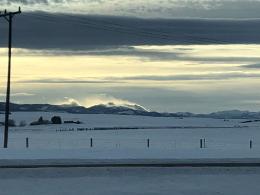Good morning. This is Alex Marienthal with the Gallatin National Forest Avalanche Forecast on Sunday, December 18th at 7:00 a.m. This information is sponsored by Highline Partners and World Boards. This forecast does not apply to operating ski areas.
Since yesterday morning one inch of snow fell near West Yellowstone and no snow fell elsewhere. This morning temperatures are zero to 20 F, and wind is west-southwest at 15-30 mph with gusts to 45 mph. Today, temperatures will reach teens to low 20s F with wind from the southwest-west at 15-30 mph, and a few flurries of snow are expected near Cooke City and West Yellowstone. The next measurable snowfall is expected Tuesday and Wednesday.
Last Wednesday and Thursday the mountains near Bozeman and Big Sky received 1-2 feet of low density snow. This snow was blown into thick drifts by moderate to strong westerly wind which shifted to southwest yesterday. Recently formed drifts are 1-4 feet deep, and can break under the weight of a person and avalanche on steep slopes. On Friday, on Saddle Peak a skier triggered an avalanche in wind-drifted snow that broke 2-4 ft deep and 150 ft wide (details and photo). He was carried almost 500 feet and luckily was not buried or injured. Yesterday, skiers in Hyalite saw recent natural avalanches of wind-drifted snow (photo and details). Be cautious of steep wind-loaded slopes, especially where an avalanche would carry you into consequential terrain like over cliffs or into trees.
We have found buried weak, sugary snow on most slopes. Yesterday we found this weak snow in the northern Bridger Range (video), and earlier in the week we found it on Buck Ridge (video) and Mt. Ellis (video). This weak layer can cause avalanches to break deeper and wider, so it is worth digging to look for and assess before traveling on any steep slope.
Today, human triggered avalanches are possible and the avalanche danger is MODERATE.
Weak layers of sugary snow buried 2-4 feet deep, and deeper on wind-loaded slopes, make large avalanches possible for a person to trigger today. Since nearly 3 weeks ago when these layers were buried, we have seen natural and human-triggered avalanches large enough to bury a person, and some large enough to break trees or destroy a car (Natural avalanches last week near Cooke, observation from an avalanche triggered from below last week).
Without much recent snow and wind-loading, the likelihood is slowly decreasing for triggering an avalanche on these weak layers, but the consequences remain large. Be extra cautious of travel on and underneath slopes steeper than 30 degrees. The safest strategy is to avoid steep slopes, especially those that are heavily wind-loaded. If you choose to ski or ride steep slopes, choose terrain that doesn’t have drifted snow and dig to check for the presence of buried weak layers. Avalanches are possible to trigger and avalanche danger is MODERATE.
If you get out, please share avalanche, snowpack or weather observations via our website, email (mtavalanche@gmail.com), phone (406-587-6984), or Instagram (#gnfacobs).
Upcoming Avalanche Education and Events
Please consider donating to the Friends of GNFAC Annual Fundraiser.
Our education calendar is full of awareness lectures and field courses. Check it out: Events and Education Calendar.
TODAY! Saturday, December 17, 10 a.m., Avalanche Awareness - Winter Wonderland at Montana Science Center. More information HERE.
Monday, December 19, 5:30 p.m., Women in the Backcountry at MAP Brewing. Free.
Every Saturday, 10 a.m - 2:00 p.m. Avalanche Rescue Training, drop in for any amount of time. Round Lake Warming Hut, Cooke City. Free.
Send us your observations. They do not have to be fancy, just a few sentences. Did you see any avalanches? How much new snow? Is the wind blowing and drifting snow? Pictures, snowpits and stability test scores are also welcome, but not necessary. You can help us fill in the gaps of our field work.


